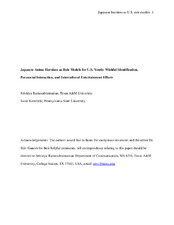| dc.creator | Ramasubramanian, Srividya | |
| dc.creator | Kornfield, Sarah | |
| dc.date.accessioned | 2020-05-21T19:54:25Z | |
| dc.date.available | 2020-05-21T19:54:25Z | |
| dc.date.issued | 2012 | |
| dc.identifier.citation | Srividya Ramasubramanian & Sarah Kornfield (2012) Japanese Anime Heroines as Role Models for U.S. Youth: Wishful Identification, Parasocial Interaction, and Intercultural Entertainment Effects, Journal of International and Intercultural Communication, 5:3, 189-207, DOI: 10.1080/17513057.2012.679291 | en |
| dc.identifier.uri | https://hdl.handle.net/1969.1/188012 | |
| dc.description.abstract | This paper uses survey methods (N=385) to examine the underlying processes through which U.S. fans create meaningful relationships with Japanese media characters. Specifically, this study tests an integrated model linking character perceptions, wishful identification, and parasocial relationships in the context of fans of shōjo, a heroine-centric genre of Japanese anime. Results suggest that liking a heroine's pro-social traits leads to greater wishful identification and more intense parasocial relationships with the heroine. Theoretical implications for reception studies and intercultural entertainment, and practical implications for role-modeling effects of positive female characters on young audiences are discussed. | en |
| dc.language.iso | en_US | |
| dc.publisher | Journal of International and Intercultural Communication | |
| dc.subject | Media effects | en |
| dc.subject | Japanese Anime | en |
| dc.subject | Wishful Identification | en |
| dc.subject | Parasocial Interaction | en |
| dc.subject | Pro-Social Effects | en |
| dc.title | Japanese Anime Heroines as Role Models for U.S. Youth: Wishful Identification, Parasocial Interaction, and Intercultural Entertainment Effects | en |
| dc.type | Article | en |
| local.department | Communication | en |
| dc.identifier.doi | 10.1080/17513057.2012.679291 | |


